What is a sales funnel and to optimize it
The marketing funnel or sales funnel, often used interchangeably, is a structural representation of a customer’s journey with a brand.
The funnel is used to represent every touchpoint from the initial stage when a user learns about your business to the actual conversion, where they make a purchase. The impact of the funnel doesn’t have to end with the first purchase. It can extend through the entire lifetime journey of the customer.
Updated on Aug 12, 2020
In this blog, we will talk about the funnel from a holistic perspective—covering the definition of a funnel to the various stages of the sales funnel, how to build a funnel marketing strategy and optimize it, and also how Insider can help you optimize your funnel to get the best results.
What Is A Marketing/Sales Funnel?
Every brand wants visitors to arrive at their website, and engage with their offerings. Mostl brands would want their customers to follow a similar path like this:
- Hear about your brand/search for your brand
- Arrive at your website
- Browse through your offerings
- Make a purchase
- Come back for more!
These steps, broadly speaking, are the stages that make up the Marketing funnel. But the reason why it’s called a funnel is that the number of people who are present at the top is high and as the funnel narrows down, the number of users who make it to the conversion stage are usually a fraction of the initial number.
The Stages of a Marketing/Sales Funnel
As a rule of thumb, the marketing/sales funnel can broadly be divided into 3 segments-
- Awareness
- Consideration, and
- Conversion
- Loyalty
- Advocacy
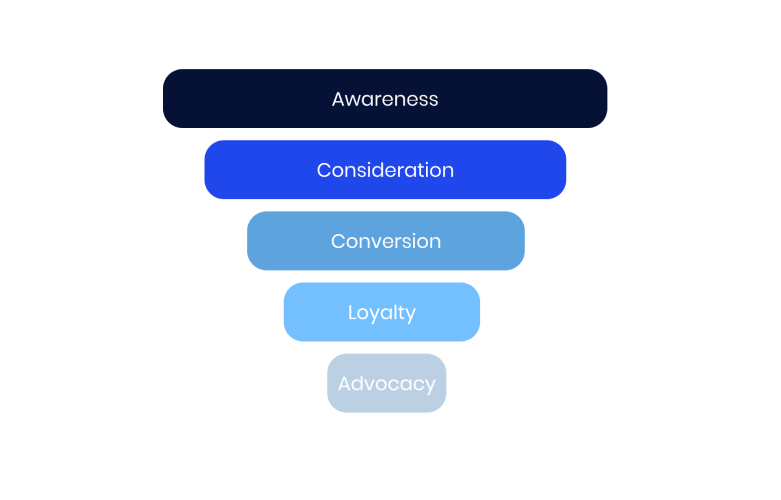
One could say that these are the basic tenets of a marketing funnel that have remained intact since the nineteen hundreds, but in the diverse world that brands operate in today, no one representation of the funnel is accepted universally.
This is a good thing, as brands need to tailor their funnel to their unique mode of operation. Only then can they truly optimize their funnel and customer journeys—delivering relevant experiences and optimizing conversions along the way.
Awareness
This is the stage where prospective customers are made aware of the brand and its offering through branded content and marketing strategies that aim to educate the audience, capture their attention and lead them to the website
Consideration
Once a user enters the website, the next step is to get them to start browsing, understand what they are looking for, provide relevant recommendations to leverage the power of the crowd through social proof and motivate them to convert (make a purchase).
Conversion
This is the gold pot—the action that every brand seeks from the user. Smoothening the journey that leads to a seamless “purchase” is what this section of the funnel is all about. Considering the increasing drop-off rates along the funnel, the number of users who make it this far will be considerably lesser than the number who started out. Therefore it becomes vital that brands are able to achieve maximum retention at this stage.
Loyalty and Advocacy
Certain marketing schools of thought also support loyalty and advocacy as parts of the funnel, as it adds to the overall effectiveness of the marketing strategy and helps brands with retention. According to an Accenture Strategy report, titles, ‘Digital Disconnect in Customer Engagement’ brands lose $1.6 trillion every year on account of users leaving them.
User drop-outs along the funnel is a reality, and the crowd size thins as they progress further down the funnel.
An Example of A Marketing Funnel
Let’s take the case of an online pet store that deals with customized pet accessories along with regular pet products. Their market study has revealed that the bulk of their potential customers are first-time pet parents who make use of social media forums extensively to gain insights, share reviews and shop.
Having identified its target audiences, the brand proceeds to run Facebook and Instagram Ads in order to drive traffic to their website. With prospects having arrived at the website, the next ideal situation for the brand would be to have them sign up and move along the funnel. And there you go. Prospects turn into leads.
Now comes the nurturing—over the next few weeks the brand sends out informative content to these leads, educating and informing them about its products and offerings. At this stage, brands may also add in certain incentives such as first-purchase discounts, subscription offers etc., in a bid to get the prospects to convert.
Conversion is a key success metric for all brands. However, it is not an end in itself. Almost 60% customers leave after their first purchase. The average return rate for first-time visitors is around 25%, Returning visitors however, tend to spend 20% more than first-timers.
This is why brands need to repeat the process and get customers to re-engage and purchase again from their website. Re-engagement is a vital part of the sales funnel, yet one that is often overlooked.
Marketing Funnel or Sales Funnel?
Used interchangeably—the term “marketing funnel” and “sales funnel” do cause a fair bit of confusion, particularly over which team owns the funnel?
Let’s keep in mind that there is no perfect funnel that works as a one-size-fits-all strategy, and therefore both marketing and sales contribute to its effectiveness.
Traditionally, the initial stage of awareness is where marketing has played a greater role while sales picks up from the consideration stage all the way to conversion.
The modern-day consumer is no longer dependent on a brand’s marketing efforts alone to get informed about its positioning. Access to digital content and comparison forms entail that consumers are already well informed about a brand and its offerings before they arrive at the website.
As access to the internet and avenues for independent research start playing greater roles in consumer behavior, it impacts their purchase decisions and consumer awareness is no longer confined to relying on a brand’s messaging alone.
One could argue that in today’s digital world, the funnel is split vertically between Marketing and Sales, with both teams playing an equal role in optimizing its effectiveness.
How to Build an Effective Sales Funnel
Now that we’ve got a basic understanding of what a marketing/sales funnel looks like, let’s look at how we can build an effective funnel. But before we do, let’s zoom into the funnel and analyze it in greater detail.
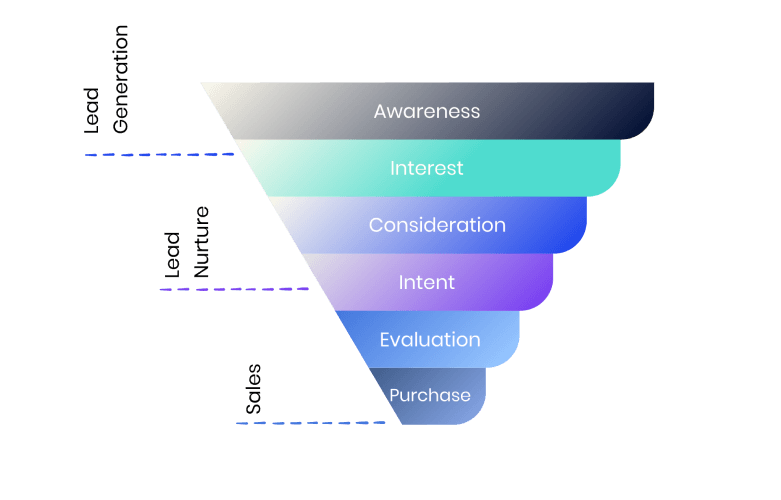
As we’ve seen earlier, the marketing funnel consists of 3 broad stages- awareness, consideration and conversion. These stages serve three specific purposes, namely-
- Lead Generation [Awareness]
- Lead nurturing [Consideration]
- Sales [Conversion]
Lead Generation
This part of the funnel is all about the marketing campaigns run by brands and customer research that make up the awareness stage.
To engage with consumers at this stage of the funnel, brands need to invest in events, blogs, webinars, social media ads and search ads to maximize their outreach and grab the attention of their target audience.
Lead generation should be a continuous process as it entails a long cycle and doesn’t bring results overnight. Brands that invest in understanding their audience at this stage will be able to deliver relevant and engaging lead-generation content. These days, brands can make use of many customer journey builder tools to engage, nurture and convert users along the funnel and across the customer lifetime.
Lead Nurturing
Lead generation should naturally be followed by lead nurturing. This is the stage where customers are introduced to the brand’s positioning and products through engaging content and/or offers.
Emails, targeted content, newsletters etc. are common mediums that brands use to nurture their leads and move them onward, into the funnel and on their path to conversion. It is also important for brands to remember that at this stage, potential customers are looking for greater information about the products and services offered by the brand.
This is the time to educate and inform these customers about the brand’s USPs through case studies, testimonials, free trials; by making use of automated email campaigns and targeted ads.
Sales (Conversion)
At this stage of the funnel, the audience is ready to receive marketing and sales pitches that advocate the quality of a brand’s products.
We’re talking about demos, trial packages, bundles—relationship building through sales interactions and relationship management.
The metric here will be the purchase or the “conversion” of the user from being a ‘prospect’ into a paying customer at the end of the funnel. A user’s journey through the funnel is long, and often winding, but given the right interactions at each stage of the funnel, brands will undoubtedly be able to improve the conversion rates as the funnel narrows down.
A Step-By-Step Guide to Building a Funnel
So you’re probably wondering how to go about building a marketing funnel? This section’s got you covered—it’s simpler than you think.
- Get to know your audience
Knowledge is power and the more you know about your audience the better your sales funnel becomes. It’s futile to market from a hilltop to everyone below. Instead, market to those users who are a good “fit” for your brand.
- Get their attention
Your sales funnel can only start working when users enter it. Even the most amazing sales funnel won’t fetch you results unless you can entice your audience to enter it. So the process starts with getting the right content in front of your audience. Organic efforts such as SEO optimization, blogs, SM posts and paid marketing such as Facebook ads and Google adwords can help you grab their “attention”.
- Get them to a landing page
Now that people have started engaging with your posts and you have their attention, it makes sense to lead them somewhere, right? You would need your prospects to reach your landing page, that spells out your positioning and your offers. The aim of this page should be to lead them onward to the next step—a clear call-to-action that defines their final step (such as downloading a piece of content or signing up for a subscription).
- Get started with nurturing campaigns
Now that your prospects have turned into leads, it’s time to start marketing to them. However, make sure not to flood them with content. Keep the frequency of your marketing content to just what’s required to stay on top of their minds, not break their minds. Educating them, convincing them and making an offer they can’t refuse are all part of “lead nurturing”. At the end of this nurture period, you Should have inspired your leads to convert and make a purchase.
- Get the circle rolling
In a bid to get new users to convert and to grow your user base, it is paramount to remember that these users need to be retained. The marketing funnel is a perfect blend of customer acquisition and customer retention. Continue engaging with your existing users, inspire trust, build loyalty and keep them involved in your growth as they are a part of it.
Why It Helps to Optimize the Sales Funnel?
What sets you apart from your competitor? The harsh answer – not much.
For your prospects, your brand is just one of the names in a highly competitive list of options they have. Effective marketing or sales funnels can help you deliver experiences that are relevant to what your prospects are looking for.
Optimizing your funnel will require you to position yourself as a brand that stands out from its competitors—you want them to choose your products or services over the others. Don’t focus on pushing the sale, that will happen organically. Instead draw your prospects’ attention to the value of your offering.
It may sound like hard work and a lengthy process, but your competitors are doing it and it is the only way to survive in today’s competitive digital market. When you make the effort to build a funnel that resonates with what you stand for and what your audience is seeking, you will find that it performs effectively.
An optimized funnel is one that works to keep your brand on the top of your customers’ minds. Combined with relevant content, you can build trust and ensure your customers don’t need to look elsewhere.
How to Measure the Effectiveness of a Sales Funnel?
The biggest measure of success for your sales funnel is the frequency of refinement it gets. As you learn more about your target customers, their behavior/intent, and as your brand grows and diversifies, it becomes imperative to enable your sales funnel to adapt. This adaptation of the funnel is what will bring success.
For the purpose of metrics, one might say an accepted benchmark is a healthy conversion rate. For eg. How many people created an account by clicking on your Facebook ad? Tracking these metrics can help you identify what might not be working for your brand and tweak future engagements to fit perfectly.
Another effective way to measure the success of your funnel is to customize user engagement at each stage of the funnel-
- How is your content performing in the `awareness’ stage?
- What percentage of your leads share their email address?
- How impactful are your marketing efforts? (email drip campaigns, web push and app notifications)?
- What is your churn rate? At what stage of the journey do users usually drop off? How many users continue to purchase from you?
By paying attention to these aspects, you will be amazed to see how the funnel can be tweaked to perfection.
Keeping your sales funnel optimized and ready to engage is a continuous process. It should be an active approach, not a passive one.
Are There Limitations to Optimizing the Funnel?
No. You can optimize your funnel to any number of scenarios. You can design and build various funnels to engage users at various touchpoints of their journey as well as engage them for specific situations.
In addition to the scenarios mentioned above, users may also leave your website as the product they are searching for may be out of stock. You can re-engage with these users once the product is back on your virtual shelf through the use of Stock Push notifications.
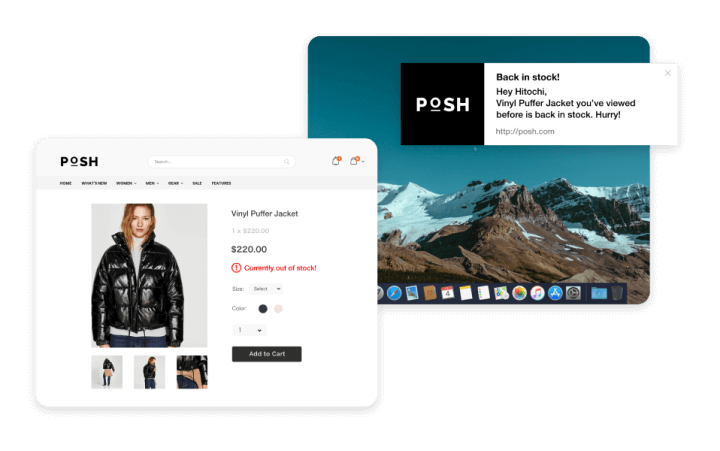
Or take the case of price-conscious users who seek discounted products. Alert and engage these users with the help of Price Alert push notifications whenever a product witnesses a drop in price or when an offering is likely to increase in price in the near future. Nudge users to make a purchase and improve conversions by creating a sense of urgency.
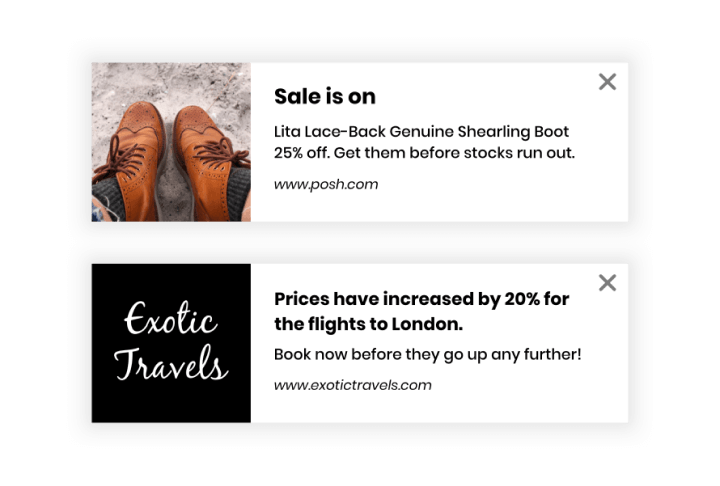
How Can Insider Help Optimize the Marketing/Sales Funnel?
When we think about the funnel, we often visualize an unidirectional flow, where new users sign up and eventually make a purchase. But funnel optimization can be applied in a variety of scenarios, not necessarily limited to converting prospects into customers.
Optimizing the funnel has multiple benefits (in addition to increased conversion rates) for the brand, from improving Average Order Value (AOV) to optimizing the Customer Lifetime Value, Average Revenue Per User (ARPU) and reducing customer churn.
Let’s dive into a few use-case scenarios, where you can optimize your marketing funnel and deliver improved user experience, while achieving optimum results.
Category Funnel
Many times, e-commerce companies find that users show more than a passing interest in a product. They do so by browsing various categories of the product. However, this doesn’t always translate into a conversion as they leave the page without making a purchase.
Marketers can take heart from such user behaviour. The fact that they are browsing the product across categories means this is a user segment that is more likely to purchase than others. It will pay to follow up with them.
Here’s How Insider Can Help
For the more-likely-to-purchase user category, Insider’s Web Push notifications can help engage with them and nudge them into making a buying decision. Using this tool, businesses can push the right messages, enabling them to convert. They can also be addressed on a one-on-one basis with Insider’s Whatsapp Business – which can be used to deliver high value, relevant and time-sensitive information to users on their Whatsapp chat.
Onboarding Funnel
Space is not a constraint on smart phones today. Often, users download applications on their mobile handsets and then forget about them. Say, you are an online retail business. It’s a crowded market out there and users often download several online retailing applications but end up not using them. How do businesses encourage these users to start using their applications?
Here’s How Insider Can Help
Try Insider’s Mobile App Push tools that can take your application’s mobile user engagement notches higher using personalized push notifications to boost open rates.
To engage with such users, businesses can opt for Insider’s Dynamic Content feature, which automatically personalizes user attributes in push notifications to deliver relevant experiences in real time. Retail companies that have both an online and offline presence can also try Insider’s Geofence, to target mobile app users with real-time notifications to drive interaction as soon as they enter a geofence area.
New User Registration Funnel
A challenge for many marketers is turning new visitors who arrive at your website into leads that you can nurture and eventually convert into paying customers. But this is easier said than done—not everyone who lands on your website is looking to make a purchase, or give out information.
Remember most of these users are in the consideration stage of the funnel and are in the process of doing their research before zeroing on a brand. As a marketer the value-add you provide to users at this stage is to identify with their intent and offer relevant and personalized engagement.
Here’s How Insider Can Help You
Insider’s AI-powered Journey Builder—Architect—can help you engage users with the right content and across the various touchpoints they move across during this stage.
- Once a user lands on your website, you can engage them to register using personalized lead generation templates.
- For those users who do not register in the first visit, Architect can help follow up with a personalized offer
- You can further engage users who still don’t sign up by providing a loyalty card
What makes this strategy work is how Architect can help you engage with these customers through multiple touchpoints, such as web push notifications, targeted ads and mobile web push. Architect identifies the channel these users are most active on and automates the engagement to target the user on their preferred channel, at the right time.
Cart Abandonment Funnel
Another relevant example where funnel optimization can yield great results is while dealing with “cart abandonment”. Every year cart abandonment costs businesses $2 to 4 trillion. A 65% cart abandonment rate can leave a 97% gap in conversion rates.
The constant challenge for marketers is reducing abandonment rates, as this is where a lot of related marketing metrics can also be optimized, such as Average Order Value (AOV).
Here’s How Insider Can Help You
When users abandon their cart and exit a website, it translates into a lost opportunity, a highly undesirable outcome for marketers. However, out of sight doesn’t have to mean out of mind, and Insider’s Web Push notifications are a great way to target and engage offsite users.
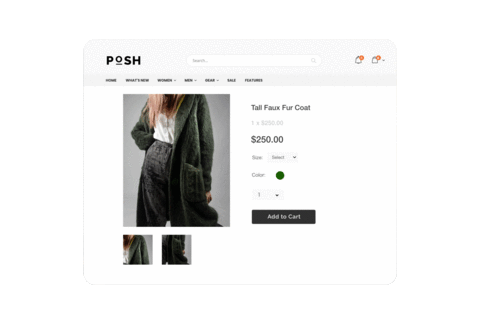
When users add a product(s) to their cart but exit your website without completing the purchase, you can add them into the ‘Cart Abandonment’ funnel. Insider’s Architect can then engage these users through reminder emails and web push notifications about the pending items in their cart.
Let’s look at how Insider’s web push notifications uplifted conversion rates for Carrefour, a hyperlocal, multi-format, omnichannel retail group. Carrefour tapped into the Insider platform while making inroads into the Taiwan market.
In order to manage and grow the performance of both their physical outlets and online store, Carrefour used a range of features like mobile messaging, pushes and emails. The company’s first step was to fully understand their visitors’ needs, preferences and online behaviour. That’s where Insider’s AI-backed Growth Management Platform came in. The technology enabled Carrefour to deliver a tailored, one-of-a-kind website experience to each customer, helping foster loyalty and return visits.
The retail giant also used Insider’s Web Push Notifications as a new way to engage with customers who had abandoned their carts. This allowed Carrefour to bring back lost or distracted customers by providing them unique selling points about their products. It resulted in an additional $11,000 in the first month of implementation and a conversion rate uplift of 350%.
Returning User Funnel
This is a scenario that most online retailers are familiar with. A new user checks into your website, browses around and leaves without making a purchase. A few days later, she returns again. How do businesses engage with her so that she makes a purchase on her subsequent visit?
Here’s How Insider Can Help
The first step for businesses looking for higher conversions is to understand their audience. To do this, they can opt for Insider’s Visitor Segmentation. It uses AI-backed predictions, behavioural patterns, purchasing trends, historical data, geolocation and weather forecast to create custom-made segments. This can help them have relevant conversations with users.
Another effective way to engage with returning users is Insider’s Web Versus tool. It’s common for users to make multiple visits to your site before they seal a purchase deal. Convert them by providing an easy way to find and compare products, keeping their past browsing behaviour in mind.
Wondering How to Get Started?
If you got this far and want to know how you can start building a highly-converting funnel, we’re here to help. Talk to our industry experts who will walk you through the steps for building a right-fit funnel for your market segment. Request a personalized demo.



















